- Home Page
- Power Kites
- Landboarding Gear
Kite Landboarding Gear
Kites, Boards, and Other Stuff
The requirements for kite landboarding are quite similar to those for snow-kiting.
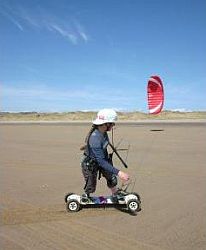 Flat and smooth
Flat and smoothYou want a steerable kite with decent pull, crash-proof in case it contacts the ground hard, and packable into a small space for traveling convenience.
Also desirable is the ability to relaunch off the ground without having to walk over to it and the ability to "de-power" the kite during strong gusts of wind.
And of course, the rider races along on a board. That's on wheels, rather than just planing along the surface as with snow or water.
Just
like in other forms of traction kiting, it's a great idea to start by
spending some time flying a small "trainer kite." This gets you familiar
with steering and the changes in line tension in different weather
conditions and where the kite is in its operating window.
On this site, there's more kite-making info than you can poke a stick at :-)
Want to know the most convenient way of using it all?
The Big MBK E-book Bundle is a collection of downloads—printable PDF files which provide step-by-step instructions for many kites large and small.
Every kite in every MBK series.
The Kites
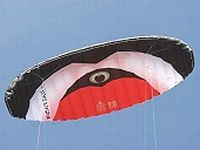 Photo courtesy of Cobra Kites
Photo courtesy of Cobra KitesOne kind of kite in particular is suitable for kite landboarding—the ram-air foil. It's no coincidence that these look like small paragliders, since the parafoil kite design came first! Full-size paragliders were later developed from the foil kite idea.
Foils are flexible, with an upper and lower surface when inflated. Openings at the front edge allow air in that pressurizes the kite and makes it behave like an aircraft wing. Most depowerable designs have four lines, which allow steering and also the "angle of attack" to the wind that controls power. Like many modern kites of all types, ripstop nylon is the most commonly used material.
At the beginner or intermediate level, most kites are sold as a complete package with lines, control bar, and a rucksack to carry everything around in. Add in a harness and the rider can wear it to take most of the kite's pull—no more tired arms.
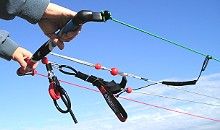 Photo courtesy of Cobra Kites
Photo courtesy of Cobra KitesPulling one end of the bar at a time steers the kite. Pulling both ends in toward your body increases the pull of the kite, while letting the bar out decreases the pull of the kite.
For emergencies, some kites even have quick-release pins to let you get rid of the kite in a hurry.
Another approach to emergencies is to use a hook knife to slice through the lines. Some paraglider pilots have these handy too, for similar reasons.
For starting kite landboarding, just about any medium-sized depowerable traction kite will do. There's a wide range available, and not surprisingly perhaps, it's the paraglider manufacturers who make the best ones. They also happen to be the most expensive!
When deciding just how big a kite you want, here are the things that can affect your decision:
- a small kite is handy for learning the basics of power kiting
- average size required is around 3 square meters—go bigger depending on how good you are with using depower!
- slower surfaces such as grass or soft sand will require bigger kites
- the stronger the wind, the smaller the kite that is needed—ignoring this is dangerous
The Boards
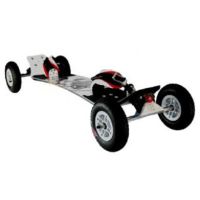
I won't get into huge detail about the boards used in kite landboarding, since this is a kite site after all!
Many kite boarders use "mountain boards," which are basically oversized skateboards. The wheels are pump-up rather than hard as on traditional roller skates.
These boards were originally designed for downhill racing and freestyle for when all the snow had disappeared from the slopes! That's because snowboarders decided there must be a way to get down the mountain fast, even with no snow.
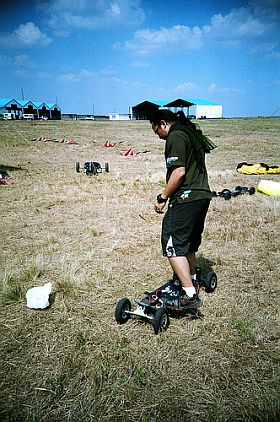 Photo courtesy of JC Medina
Photo courtesy of JC MedinaHence the birth of mountain boarding, which also came to be known as dirt boarding or all-terrain boarding (ATB). So if you hear someone talking about their dirtboard or ATB you'll know what they are talking about.
Since so many people are into these sports, there are many manufacturers all trying to get a piece of the action. That means more different kite board designs than you can poke a stick at!
Even so, it's possible to make some very general statements about all these boards. Here's a few reasons to consider the most expensive boards, if you can afford them:
- These boards are easier to use since they allow turning while traveling at lower speeds.
- Another thing about the pricey boards is that most of them have "active suspension"—very handy for doing jumps or going over rough ground.
- Composite construction is more expensive but results in much lighter boards. This is important for kiting.
Boards for kite landboarding are a bit shorter than snowboards. A typical landboard is about 110 cm (43 inches) in length, with four wheels. The wheel diameter is usually between 18 cm and 33 cm (7 in. and 13 in.). An exception are the two-wheel in-line designs that have 51 cm (20 in.) spoked BMX wheels. There are even some three-wheeled designs out there.
Other Kite LandBoarding Gear
Did I say all you need is a kite and a landboard? That's not quite true if you want a painless experience! Here are all the other bits of gear that complete the picture:
- A ground stake (to keep the kite tethered when you're not actually using it)
- A wind meter (so you know exactly what wind strength you are dealing with)
- Spare parts and repair tape
- Tools
- Safety equipment (such as helmet, knee pads, and elbow pads)
I hope all this has at least given you an idea of what kind of gear you need for kite landboarding!
As mentioned earlier, there's more kite making on this site than you can poke a stick at. :-)
Want to know the most convenient way of using it all?
The Big MBK E-book Bundle is a collection of downloads—printable PDF files that provide step-by-step instructions for many kites large and small.
That's every kite in every MBK series.
